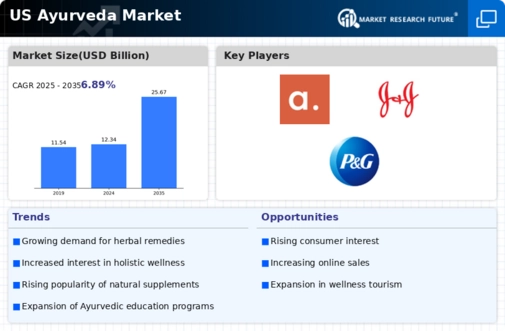Shift Towards Preventive Healthcare
There is a discernible shift in the healthcare paradigm towards preventive measures, which is positively influencing the ayurveda market. Consumers are increasingly prioritizing wellness and preventive care over reactive treatments. This trend is reflected in the rising sales of ayurvedic products, which are perceived as effective preventive solutions. The preventive healthcare market in the US is expected to grow at a CAGR of around 7% through 2025, suggesting a favorable environment for ayurvedic practices that align with this philosophy.
Growing Consumer Awareness of Health Benefits
The ayurveda market is experiencing a notable increase in consumer awareness regarding the health benefits associated with ayurvedic practices. As individuals become more informed about holistic health approaches, the demand for ayurvedic products and services is likely to rise. Reports indicate that the market for herbal supplements, a significant segment of the ayurveda market, is projected to reach approximately $10 billion by 2026 in the US. This growing awareness is driving consumers to seek natural remedies for various ailments, thereby expanding the customer base for ayurvedic offerings.
Rising Popularity of Holistic Wellness Trends
The ayurveda market is benefiting from the rising popularity of holistic wellness trends that emphasize the interconnectedness of body, mind, and spirit. As more consumers seek comprehensive wellness solutions, ayurvedic practices are gaining traction as viable options. This trend is reflected in the increasing number of wellness retreats and programs incorporating ayurvedic principles. The holistic wellness market is projected to grow significantly, with estimates suggesting a value of over $4 trillion by 2025, indicating a promising future for the ayurveda market.
Regulatory Support for Natural Health Products
Regulatory frameworks in the US are increasingly supportive of natural health products, which bodes well for the ayurveda market. The Food and Drug Administration (FDA) has been working to streamline the approval processes for herbal supplements and ayurvedic products, making it easier for companies to bring their offerings to market. This regulatory support is likely to encourage new entrants and foster competition, ultimately benefiting consumers through a wider array of choices and potentially lower prices.
Increased Investment in Research and Development
Investment in research and development within the ayurveda market is on the rise, as stakeholders seek to validate the efficacy of traditional practices through scientific methods. This trend is likely to enhance the credibility of ayurvedic products and attract a broader audience. Recent studies have shown that the integration of modern scientific techniques with traditional ayurvedic formulations can lead to innovative product development. As a result, companies are allocating more resources to R&D, which could potentially lead to a more robust market presence and increased consumer trust.














Leave a Comment